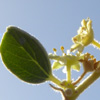Ziziphus nummularia is a thorny shrub, branched at its base and reaches a height of 1-2 meters. It has numerous flexible and convoluted, felty-whitish branches. The stipules at the base of the petioles evolved into thorns, where one is straight and about 1 cm in length, and the other is shorter and hooked. The leaves are alternate, ovate-round, felty-grayish on both sides. They have three prominent longitudinal veins and their margin is entire or notched. The inflorescences are also felty. The flowers and tiny and are arranged in small umbels at the heads of the branches. The flower is bisexual, symmetrical, with 5 triangular, felty-grayish sepals and 5 cream-colored petals. The flower has 5 stamens and the style is divided into two lobes. The ovary has two loculi, from which only one seed develops. The fruit is a spherical drupe with a diameter of 0.5-1 cm. It reddens upon ripening. The fruit pulp is sweet and edible. The seeds are dispersed by birds and mammals that feed on the fruits.
The distribution of Ziziphus nummularia is in India, Pakistan, Iraq and Iran. In Israel it is extremely rare, and a number of individuals are found solely in Nahal Shani, near the Red Canyon in the Eilat Hills. It is a “red plant” which is in danger of extinction in Israel. It differs in its felty appearance from its relative, Ziziphus lotus, which is found in the north of Israel. Another species, Ziziphus spina-christi (Christ's thorn jujube), is common in all parts of Israel. This is a tree with a broad crown, and not a shrub like the other two jujube species.
The Hebrew name of the species (“hairy”) refers to the various felty plant parts. The scientific name of the genus, Ziziphus, is apparently an evolution of the Hebrew name – “shizaf”. The name of the species, nummularia, means coin-shaped in Latin, and is named after the plant’s round leaves.
The various plant parts are used as animal food. The leaves contain saponins, and are used in folk medicine mainly as treatment against worms in farm animals. The dried fruits are used in traditional Indian medicine.
Ziziphus nummularia is suitable for planting in arid and dry regions.
Written by Dror Melamed







